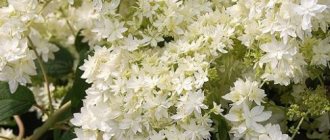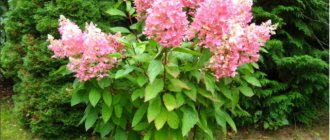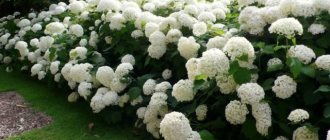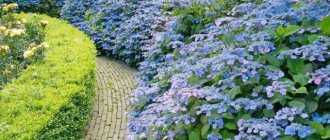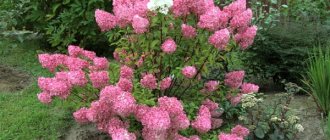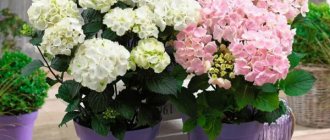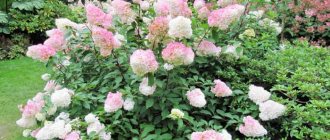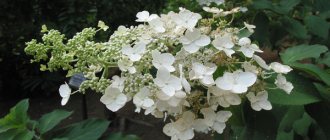Petiole hydrangea (Hydrangea petiolaris), is a species of the genus Hydrangea, a creeping deciduous shrub in the hydrangea family. The species is native to the forests of Japan, the Korean Peninsula and Taiwan. The flowering period is from June to July.
Hydrangea is sometimes called a subspecies closely related to Hydrangea anomala from China and the Himalayas, called Hydrangea anomala subsp. petiolaris. From the petiole hydrangea, the rejected hydrangea differs in size (the rejected petiole grows up to 12 m) and the diameter of the inflorescence is up to 15 cm.
Description
Petiolate hydrangea is a climbing plant with a height of 9–15 (up to 20) meters. Attached to the support by aerial roots. The leaves are glossy, broadly ovate, pointed, serrated with a long petiole, deciduous. The inflorescences are flat, approximately 20 cm. White sterile flowers have a circumference of 2.5–4.5 cm; in the center of the inflorescence there are smaller whitish fertile flowers with a diameter of 1–2 mm. The fruits are capsules, the seeds are small.
The dark green, glossy leaves of Hydrangea petiolate bloom in the spring, earlier than other deciduous climbing plants (for example, Maiden grape). The leaves are heart-shaped, smooth, long with serrated edges. Leaf density varies from plant to plant depending on the immediate growing conditions. Side branches tend to grow at right angles to the main vines.
The shoots form an uneven foliage pattern that is not possible with common climbing plants such as Maiden's Grape or Common Ivy. Petiolate hydrangea begins to bloom in June earlier than other frost-resistant hydrangeas. The inflorescences, usually 15 cm or more in diameter, consist of several hundred small fertile flowers surrounded by a crown of a dozen or more sterile ones. The sterile flowers are white, on long stalks, emphasizing their peripheral position.
The calyxes of sterile flowers are greatly enlarged, up to 2.5 cm in length and almost the same width, and have rounded outlines. The white color persists long after the fruiting flowers have faded, giving the impression of an unusually long flowering period.
The fruit is unattractive and technically a capsule (2.5 cm long). In winter, the stems and side branches have an interesting pattern, the yellowish-orange bark unevenly peeling off into large thin flakes.
Pests and diseases
Climbing hydrangea is vulnerable to many pests and diseases. Most often it is affected by the following diseases:
- Gray rot. The leaves and shoots of the plant first become colorless and gray, then become covered with black spots.
- White rot. It is characterized by rotting of the roots, blackening of the shoots and the appearance of a whitish coating on them.
- Chlorosis. Appears as a result of a lack of iron in the soil. The leaves turn yellow ahead of time, but their veins remain green.
- Powdery mildew. Initially, yellow spots appear on the leaves. On the outside they become brown, on the inside they take on a purple hue.
- Ring spot. It manifests itself by the presence of black dead spots on the leaves. The disease quickly provokes the death of the plant.
Spraying in summer and spring helps with most fungal infections. For this, Fundazolol, Fitosporin and other fungicides can be used. Treatment should be carried out every 2-3 weeks.
The most dangerous pests for plants are:
- spider mite;
- snails;
- aphid;
- root-knot nematodes.
It is worth regularly inspecting hydrangea for harmful insects to prevent infection. If this occurs, you can spray the vine with Aktara and other insecticides and acaricides, as well as treat it with Bordeaux mixture.
Petiole hydrangea has a beautiful and unusual appearance , which allows it to be actively used in landscape design. Fences, gazebos, trees and entire buildings are decorated with vines. The advantage of the plant is also that it is easy to care for and undemanding regarding the conditions in which it grows.
Story
Hydrangea petiolaris, a species known as the "climbing hydrangea," was introduced into horticulture in the United States in 1865 by Thomas Hogg, who was consul to Japan and, with his brother James, ran a nursery in New York. In addition to their own nursery, the brothers distributed seeds at Parson's Nursery in Flushing, New York. The Arboretum received seeds from Japan (presumably subspecies petiolaris) and has been growing it as a species since then. According to Haworth-Booth, Hydrangea anomala subsp. anomala was introduced to Britain in 1839 with subsp. peliolaris around 1878.
Garden hydrangea in landscape design
Hydrangea rightfully bears the title of “queen of the garden.” Everyone loves her - landscape designers, professional gardeners and talented amateurs. Since hydrangea has lush and voluminous inflorescences of a variety of colors, it is best adjacent to coniferous trees and stone. Interesting species combinations of different shapes and sizes. Against the backdrop of the giant hydrangea, you can plant several dwarf varieties. And how fabulous do compositions of potted flowers look, comfortably located near the entrance to the house or on the veranda!
Paniculata hydrangea in the garden
Did you know that there is an opinion that this beautiful shrub supposedly got its name thanks to Hortensia Barreova, the beloved of the French doctor and naturalist F. Sommerson, who allegedly brought this plant from China. In fact, the famous botanist's name was Philibber Commerson, and his lover and assistant was Jeanne Barre.
This bright and amazing story is worthy of a separate article, but in fairness, we note that this couple actually studied the island flora and fauna on the first trip around the world, organized by the Frenchman Antoine Bougainville.
In 1768, the team arrived on the island of Ile-de-France (now the island of Mauritius), where at that time the manager of the island, Mr. Pierre Poivre, collected unusual tropical plants. One day, the Parisian scientist was walking through the botanical garden in the company of Karl Heinrich, Prince of Nassau-Siegen (a member of the expedition). According to legend, Commerson was shown a beautiful shrub that was brought from China. Depending on the composition of the soil, spherical inflorescences of pink or blue shades bloomed on it. At this time, the prince talked about his sister Hortense and showed everyone her miniature portrait. In order to please the royal person, Philibert decided to bring a new plant to his homeland and name it in honor of the French princess.
Landing
Petiolate hydrangea takes root slowly, may not produce growth for a year or even two and blooms poorly after transplantation, prefers rich, well-drained, moist soil, and will grow in sun or shade. Once established, it has no serious pest problems. In the first two to three years after planting it grows rather slowly, but after rooting it accelerates the growth rate. Tolerates air pollution well and can grow in cities and industrial areas.
The first year or two after planting, growth may be slow or seemingly non-existent. As the bush takes root, especially if the tips of the stems can be securely attached to supports or structures, growth becomes surprisingly fast: 50-150 cm per year.
Before planting climbing hydrangea, the soil should be weeded and dug deep. It is better to plant the vine a little further from the supports, then direct the shoots towards them. The supports themselves must be strong to support the weight of an adult shrub. The distance between plants is 1.5-4 meters. In places exposed to strong gusts of wind, hydrangea shoots may break off their supports and fall to the ground; in such conditions, it is a good idea to tie up the plants.
Planting and caring for climbing hydrangea
One of the main advantages of climbing hydrangea is its unpretentiousness. Growing an ornamental plant is very easy; only minimal effort is required from the gardener.
Selection and preparation of a landing site
Hydrangea needs sunlight, but does not tolerate scorching heat and drafts. Therefore, it needs to be planted in an area where there is shading and protection from the wind, this will allow the plant to feel comfortable and maintain the ability to flower. The optimal location for the culture would be a proximity to tall trees, fences or buildings.
Lianas feel best in light shade with protection from the wind.
Petiolate hydrangea prefers soils that are acidic and low in calcium. The plant feels best on loose soils with good drainage, and if the crop is to be planted on heavy soil, then special attention should be paid to the sand.
Attention! It is impossible to fertilize the soil for petiole hydrangea with lime and ash, they have a negative effect on the health of the plant.
Landing rules
The planting hole for petiole hydrangea is prepared approximately 2 weeks before planting; the depth of the hole should be 2 times greater than the root system of the seedling. A mixture of peat, compost, clay, sand and leaf soil is poured halfway into the hole.
Before planting, the plant seedling is kept in water for 12 hours so that the roots are properly saturated with moisture. Then the hydrangea is lowered into a half-filled hole, straightening its roots, and covered with the remaining soil. The neck should be recessed by a maximum of 3 cm.
The soil in the tree trunk circle is lightly trampled down and the hydrangea is watered generously, at least 2 buckets per root. Mulch damp soil to prevent water from evaporating too quickly.
Most varieties of hydrangea grow quickly, so it is recommended to install supports for climbing shoots already at the planting stage. If vines are planted in several copies, you need to leave a space of at least 1 m between them, otherwise they will interfere with each other as they grow.
Immediately after planting, it is advisable to attach the future vine to a support
Watering and fertilizing
The climbing plant needs a lot of moisture, so it needs to be watered regularly. In dry, warm weather, you need to pour 30 liters of water into the tree trunk twice a week, in rainy weather - only once a week. The water must be purified and warmed to room temperature.
Petiole hydrangea is usually fed three times a year:
- In early spring, at the beginning of the growing season, it is necessary to add urea, sulfuric potassium and superphosphate to the root.
- During the formation of flower buds, the vine is fed with superphosphate and potassium.
- In August, 10-15 kg of compost or rotted manure are scattered under the hydrangea bushes.
Also in spring, hydrangea bushes can be watered with a pink solution of potassium permanganate, this will strengthen the plant and protect it from disease.
A moisture-loving plant needs to be watered frequently.
Pruning petiole hydrangea
In order for a petiole vine to look truly decorative, it needs to be shaped from time to time; without this, it thickens and takes on an unkempt appearance.
During the pruning process, dried shoots and broken branches are removed from the plant, leaving only 6-10 strong, healthy vines. Annual shoots are not cut off, but shortened to 5 pairs of buds. The main pruning is carried out in the spring, before the hydrangea begins to grow, and in the fall, usually only all dried inflorescences are removed from the vines.
How to cover petiole hydrangea for the winter
Due to its high winter hardiness, adult petiole hydrangea does not require special winter shelter. Even in Siberia, a liana-like plant can tolerate severe frosts; if some of the shoots freeze, then in the spring the petiole hydrangea will quickly produce new ones.
Adult vines do not need winter shelter
Advice! It is recommended to cover only vines under 3 years old for the winter.
Before the onset of cold weather, they are removed from their support and laid on boards, and covered on top with spruce branches, non-woven material or a dense layer of fallen leaves.
Where to plant?
Liana is great for cladding walls with porous surfaces, landscaping walls and fences, covering trash cans, covering gazebos, covering pergolas, trellises and posts. It looks very picturesque on the trunks of old trees. Climbing hydrangea is a good alternative to ivy; unlike ivy, it almost never freezes.
Hydrangea should not be planted too close to tree trunks or building walls; in these places the plant may experience a lack of water.
Varieties of petiole hydrangea
In gardening, the plant is represented by several popular varieties. Among themselves, the types of petiole hydrangea differ mainly in the length of the vines and the color of the leaf blades.
Petiolaris
Petiole hydrangea of this variety can grow up to 25 m in height and is perfect for decorating garden plots. Petiolaris is used to decorate buildings, fences and tall trees. The leaves of the plant are dark green, the flowers are greenish or white.
The variety is characterized by rapid growth - Petiolaris adds about 1 m in length per year, thanks to this you can decorate the garden with flowering vines very quickly
Miranda
The Miranda variety reaches about 10 m in height and blooms almost all summer with white flowers with a pleasant sweet aroma. The variety is considered one of the most beautiful because it has decorative leaves - bright green in the middle with a yellow border along the edges.
Hydrangea looks good in the garden not only in summer, but also in autumn, when the inflorescences have already fallen off
Cordifolia
Dwarf petiolate hydrangea usually grows no more than 1.5 m in height. You can recognize the variety not only by its compact size, but also by the color of the leaves - on the underside they are not bright green, but slightly whitish.
Cordifolia blooms with flowers of a delicate creamy hue.
Another characteristic feature of the variety is its slow growth, amounting to only 10 cm per year.
Take and Chance
Beautiful petiole hydrangea has an unusual appearance. The leaves of the plant are dark green with white edging along the edges and marbled in color, sometimes they acquire a completely whitish tint. Take e Chance's flowers are white, with a slight cream tint.
Flowering continues throughout most of the summer, as with other varieties
Silver Lining
Petiole hydrangea grows on average up to 2 m in height, sometimes up to 7 m. It is distinguished by deep green leaves with a white edge, the underside of the leaves is reddish.
In the summer, the variety blooms profusely with beautiful white flowers, and in the fall it completely acquires a burgundy color and looks very decorative.
Winter Surprise
Hydrangea Winter Surprise usually grows no higher than 2 m. The leaves of the variety are green, but closer to autumn they acquire a reddish, maroon or cherry hue. The variety blooms with snow-white large flowers, hence the name of the plant.
Unlike most hydrangeas, Winter Surprise has early flowering - in late spring and early summer.
Care
Climbing hydrangeas are relatively easy to grow. It is especially important to choose the right place so that the vine does not cause serious problems in the future. The shrub grows best in partial shade or shade, in a place protected from the wind. Young specimens are especially susceptible to drought and require regular watering. The species is completely hardy in USDA zone 4, but may not bloom in USDA zone 8.
When the vine reaches the upper limits of available support, climbing hydrangea reacts in the same way as ivy: it switches from vegetative growth to sexual maturity and produces flowers. Thus, a climbing hydrangea climbing a 10-meter-tall tree trunk may not bloom as quickly as one that only has a meter-long pole to climb. If flowering is a priority, provide relatively short support structures such as a 3-5 meter pole or wide ones such as stone walls.
Proper fertilizer is important when planting petiolate hydrangea next to a tree; due to tree competition, the soil can quickly run out of nutrients. Hydrangeas can be fertilized with well-decomposed compost or manure. Also mineral fertilizers for hydrangeas. All-purpose fertilizers are not suitable due to their calcium content. Excess calcium in the soil quickly leads to chlorosis (slight discoloration) of the leaves. Hydrangeas are fertilized from spring to mid-July. Then the plant is allowed to rest before winter.
The moving stems are amazingly inflexible and can break when trying to straighten them. To make matters worse, the older and thicker the stems become, the more brittle they become.
Climbing hydrangeas usually do not require pruning . If you need to limit its growth or give it shape, you can prune it when the vine finishes flowering.
Propagation of climbing hydrangea . Like other types of hydrangea, it can be propagated by summer cuttings. However, in amateur conditions it is easier to use layering.
Why does petiole hydrangea not bloom?
Although most varieties are quite attractive in themselves, hydrangea is usually planted in the garden in order to admire its lush and bright blooms. But it happens that the plant does not bloom, and there are several reasons for this:
- Damage by pests or diseases. If spider mites, aphids and other insects have settled on the plant, or it has suffered from fungal diseases, then it may not bloom. Hydrangea will not have enough strength to form buds.
- Lack of light. Although petiole hydrangea can grow in light shade, flowering can only be achieved from it in the presence of good lighting.
- Excess nitrogen in the soil. If the soil is oversaturated with fertilizers, and in particular nitrogen, the plant will grow quickly, but will not be able to form flowers.
- Incorrect trimming. Heavily dense plants bloom poorly or do not bloom at all. All their energy goes into maintaining the green mass. Also, flowering will not take place if you carelessly cut off annual shoots; it is on them that flower buds are laid.
Important! Petiole hydrangea has good frost resistance, but is vulnerable to return frosts. Therefore, you may not be able to wait for flowering after a cold spring; the buds will simply freeze and will not be able to bloom.
Reproduction by layering
Since old stems are notoriously fragile, in early spring you need to select a young, thin stem that is low, long and flexible enough so that the shoot can be easily bent to the ground. Place the brick on the soil-covered stem to support it (if necessary) and to prevent rain from washing away the soil. Drive a thick stake into the ground next to the buried vine, covered with soil, and tie the top of the stem to it as close as possible without breaking the stems; if there is support, the vine will take root faster.
Use in the garden
Petiolate hydrangea can be effectively used as a ground cover plant in hard-to-reach places. Good for stone fences or brick walls, although the growth rate is slower in such areas, the growth rate increases if the vine is wrapped around a tree.
When growing petiole hydrangea, you should take some precautions. In the case of a wall, especially in a building, the vine should be grown on the dark side.
The north or northeast side is better suited for growing. If grown in the south, the bush may be damaged by the sun and perform poorly.
It should be noted that hydrangeas drop all of their leaves as one unit, usually in early winter, which can be a challenge when harvesting. Therefore, planting against a wall behind existing plantings such as Rhododendron and Enkianthus should be avoided. Petiolate hydrangea climbs by means of secondary roots, which, penetrating into the substrate, apparently cause little damage than other climbing plants. Haworth-Booth suggested growing petiolate hydrangea along with beautiful Nasturtium.
A fine example of Hydrangea petiolate grown from seed in 1892 can be seen in the northeast corner of the office building on Jamaica Plain.
Growing a climbing hydrangea on a tree should be started on a mature specimen, since over time the vine will begin to grow quickly and braid all the branches.
How to propagate petiole hydrangea
To increase the population of climbing vines on your site, you can propagate the existing plant without purchasing new seedlings. Basically, gardeners resort to two methods of propagation.
Cuttings
Climbing hydrangea vines propagate well using woody cuttings. At the beginning of summer, a stalk about 15 cm long with at least 2 nodes is cut from a healthy woody stem, the lower leaves are removed and placed in a solution with a root formation stimulator for a day. Then the shoot is planted in a box with a sand-peat mixture, watered and covered with film.
Lianas propagate well from cuttings and seeds
From time to time the film is removed to ventilate the shoot and water it again. When the young petiole vine gets stronger and begins to grow, it is transplanted outdoors, usually the next year.
Seed propagation
The method is used infrequently, since it is difficult to propagate petiole hydrangea from seeds - efforts may not be crowned with success. Purchased seeds are sown in plastic or peat pots with moist nutrient soil, consisting mainly of sand and peat. The container is covered with glass or wrapped in film and placed in a room with a temperature of at least 18 °C.
Before the first shoots appear, the plantings only need to be periodically moistened and ventilated daily. Typically, seedlings appear from the ground after 1.5 months; if you plant the seeds at the end of winter, then in April the seedlings will produce their first leaves.
After the leaves appear, the seedlings can be planted. It is advisable to transfer the plant to the ground only after a year, when the seedlings are properly strengthened.
Lianas are usually transferred to an open area in the second year of life.
